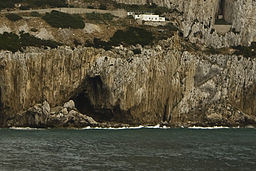- Gorham's Cave
-
Gorham's Cave 
View of Gorham's Cave on the east face of the Rock of Gibraltar.Location South east-facing face of the Rock of Gibraltar, Gibraltar Geology Limestone Number of entrances 1 Gorham's Cave is a natural sea cave in Gibraltar, considered to be one of the last known habitations of the Neanderthals. It is located on the south east-facing face of the Rock of Gibraltar. When first inhabited, it would have been approximately five kilometres from the shore but, due to changes in sea level, it is now only a few metres from the Mediterranean Sea.
Contents
Discovery
The cave is named after Captain A. Gorham of the 2nd Battalion Royal Munster Fusiliers who discovered it in 1907 when opening a fissure at the back of a sea cavern. Capt. Gorham inscribed his name and the date of his discovery in lamp-black on the wall of the cave which has borne his name ever since. After this initial discovery, it seems the cave was forgotten at least at an official level as Gibraltarian historian and potholer, George Palao, recalls an inscription on the cave wall that read "J. J. Davies 1943" [1]
Archaeology
Since its discovery, Gorham's Cave has been a site of considerable archaeological interest.
History
A few years later two Royal Engineers, craftsmen Keighley and Ward, were the first to find an archaeological deposit in the cave when the beach leading to Gorham’s Cave (Governor's Beach) became temporarily accessible from the cliffs above via a pile of spoil that resulted from tunnelling inside The Rock. Gibraltar newspaper reports of the time report that a quantity of pottery, stone tools (from the Neanderthal period), and some human and animal remains had been unearthed at the cave. The Royal Engineers told Rev. F.E. Brown of the Gibraltar Society of their findings who in turn informed the Governor of Gibraltar, who visited the site and called for further investigations to be carried out. The results of these investigations were detailed in a report sent to the British Museum and the cave was closed pending their advice on the matter.
In 1945, a Lieutenant George Baker Alexander, Royal Engineer and a graduate geologist from University of Cambridge arrived in Gibraltar and, in his own time, conducted a thorough geological survey of Gibraltar which concluded with the production of a new geological map of The Rock. Lt. Alexander became the first to excavate Gorham’s Cave but details such as the date or from whom he obtained permission to do so are unknown. Any personal records were never made public. It is known however, that his excavations in the cave were carried out before his forced departure from Gibraltar in 1948 when the Gibraltar Museum Committee challenged his methods.
In the spring of 1948, the Governor was once again in correspondence with the British Museum requesting that they continue any further explorations of the cave. However, the British Museum had no staff available at this time and forwarded his letters to Professor Dorothy Garrod at Cambridge who had previously excavated at another site in Gibraltar, Devil’s Tower Rock Shelter, in 1927 to 1928. She was also unable to undertake the work and asked Dr. John D'A Waechter, a fellow of the British Institute of Archaeology in Ankara, if he could fit the work into his own programme in Turkey. Dr. Waechter arrived in Gibraltar in September 1948 and spent two months digging test pits to see if an extensive excavation was justified. Waechter reported his success verbally to the Government of Gibraltar and arranged to continue on a larger scale the following year. Dr. Waechter returned to Gibraltar again in June 1950, and except for a six week break in September and October, he worked through until March 1951. He went back to England without concluding the work and returned in February 1952, working through until July that year. During his final visit in 1954 he found that his funds for research were insufficient to enable him to complete the excavations so he requested financial assistance from the local government. The standing Finance Committee subsequently approved his plea and he was able to complete his excavation programme.[1]
Ongoing excavation
Excavation of this site has resulted in the discovery of four layers of stratigraphy. The first level has produced evidence for 8th to 3rd centuries BC use by Phoenicians. Below that is evidence for brief Neolithic use. Level III has yielded at least 240 Upper Paleolithic artefacts of Magdalenian and Solutrean origin. Level IV has produced 103 items, including spear-points, knives and scraping devices, identified as Mousterian, and shows repeated use over thousands of years. AMS dating gives dates for this level of between 33 and 23 kyr BP — the researchers felt that the uncertainties at this time depth made calibration impractical. They suggest occupation until at least 28 kyr BP and possibly 24 kyr BP.[2] No fossil remains have been found that would allow identification pointing to either Neanderthal or Anatomically Modern Human inhabitants, nor associate with findings of a modern human in nearby Abrigo do Lagar Velho, Portugal of 24,500 years ago that allegedly featured Neanderthal admixtures,[3] but Mousterian culture is normally identified with Neanderthals in Europe.[4]
UNESCO World Heritage Site nomination
In November 2010, the Government of Gibraltar announced that Gorham's Cave would be put forward for potential nomination as a UNESCO World Heritage Site. Professor Clive Finlayson, Director of the Gibraltar Museum, is responsible of co-ordinating the efforts to achieve such nomination. The first step has been the submission of a proposal to the United Kingdom cultural authorities in order to get Gorham's Cave added to the UK's World Heritage Tentative List. Such a list is revised every 10 years, and the process for a new list was ongoing at the date of the submission.[5]
See also
Notes
- ^ a b Finlayson, Clive. "History of Gorham's Cave". Gibraltar Museum. http://www.gibmuseum.gi/Gorhams_History.html. Retrieved 5 December 2010.
- ^ Finlayson C, Pacheco FG, Rodríguez-Vidal J, et al. (October 2006). "Late survival of Neanderthals at the southernmost extreme of Europe" (PDF). Nature 443 (7113): 850–3. Bibcode 2006Natur.443..850F. doi:10.1038/nature05195. PMID 16971951. http://www.jscarrion.com/pdf/neandertals_nature.pdf.
- ^ Duarte C, Maurício J, Pettitt PB, et al. (June 1999). "The early Upper Paleolithic human skeleton from the Abrigo do Lagar Velho (Portugal) and modern human emergence in Iberia". Proc. Natl. Acad. Sci. U.S.A. 96 (13): 7604–9. Bibcode 1999PNAS...96.7604D. doi:10.1073/pnas.96.13.7604. PMC 22133. PMID 10377462. http://www.pnas.org/cgi/content/full/96/13/7604.
- ^ Location diagrams at Anthropologynet and BBC News
- ^ Government Seek World Heritage Status for Gorham's Cave, Gibraltar Chronicle, 8 November 2010.
External links
- Alfano S Did Neanderthals Last Longer? CBS News, 13 Sep 2006
- Rock art found in Gorham's Cave. (Spanish)
- Information on Gorham's Cave from the Gibraltar Museum website.
- History of Gorham's Cave from Gibraltar Museum website
- Stringer CB, Finlayson JC, Barton RN, et al. (September 2008). "Neanderthal exploitation of marine mammals in Gibraltar". Proc. Natl. Acad. Sci. U.S.A. 105 (38): 14319–24. Bibcode 2008PNAS..10514319S. doi:10.1073/pnas.0805474105. PMC 2567146. PMID 18809913. http://www.pnas.org/cgi/pmidlookup?view=long&pmid=18809913.
Categories:- Caves of Gibraltar
- Sea caves
- Wild caves
- Neanderthal sites
Wikimedia Foundation. 2010.

